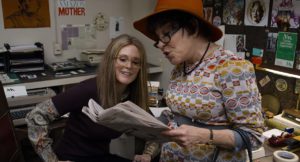Click here for the flashback interview with Julianne Moore for FREEHELD.
Julie Taymor, a visionary director if there ever was one, has done more than merely work around the inherent artificiality of the cinematic biopic. Rather, she has used it to excellent advantage in THE GLORIAS, a consideration of the life, and political education, of Gloria Steinem. From the first frame we are put on notice that this will be a film in which the emotional truth of her life is given equal weight with the factual truths that, while accurate, cannot hope to convey the same power. Hence the metaphor of the bus, on which the four Glorias, filmed in black and white, gaze out the window to watch key scenes from their lives that play out in vivid color. And when Gloria first steps off that bus, the encounter she has with a biker couple further puts us on notice that this will be a story that refuses to be predictable.

Ryan Kiera Armstrong, Lulu Wilson, Alicia Vikander, Julianne Moore
Gloria’s life is told thematically, rather than in strict chronological order, so that she can be in a doctor’s office in London in one scene, and the next pick up from an earlier scene where she is traveling India in a third-class train carriage while on a two-year fellowship in that sub-continent. The conceit of time and space being irrelevant also allows her to stride a few steps from a post office there after reading a letter from her cockeyed optimist of a father (Timothy Hutton) to meeting him in San Francisco’s Chinatown without a break in the action. We are in the realm of personal memoir, with Gloria in all her incarnations (Alicia Vikander as the young woman, Julianne Moore as the older woman, Lulu Wilson as the adolescent, and Ryan Kiera Armstrong as the child) play out not only the events of her life, but also the inner dialogues between the Glorias as different stages of their lives. There is also the externalizing Gloria’s but inner eye to comment on the action. Thus can Vikander and Moore have a brutally honest conversation on that metaphorical bus about choosing childlessness, and Gloria’s but reaction to the questions of a chauvinist television host that attempt to reduce Vikander as Gloria to her looks. That moment results in a dizzying operatic interlude that bathes said host in flame-red light as he is confronted in a fever dream of madonnas, whores, and a literal cyclone of female rage and mockery. It is perfection in its commentary. The return to reality, as Vikander is replaced by Moore, signals a change not in Gloria’s age, but as another milestone in her raised consciousness (to use the contemporary term). It’s also brutal a reminder of how careful women had to be when presenting themselves, even now, as Moore doesn’t reveal her anger on camera, though she had every right to take umbrage, but continues on calmly as the lone woman in the control booth evinces a well-modulation elation in noting to her male colleagues that Steinem is rebelling in a most unladylike way by not answering the question as asked.
Fear not, though. Story is never sacrificed to style, and Gloria’s life is covered nicely, from a nomadic childhood that kept her out of formal schooling, to her mother’s (Enid Graham) mental challenges, to the tumultuous early years of her journalism career where she was regularly shunted from serious stories to fluff pieces on dating, to her breakthrough as an undercover bunny at a Playboy Club, where she reported on the horrendous working conditions, and discovered that having donned the bunny costume might become her brand, despite the seriousness of the story. This is a Gloria that from the start does not see the world in the way prescribed for women in the 1940s and 50s, joining a black girl at her father’s barber shop to tap dance (Gloria longed to be a dancer when she was a child), to questioning her first editor about why women did the research and men did the writing. then quitting her job when he told her he expected her to meet him at a hotel later that day. She celebrated with a hot fudge sundae. Later, a well-meaning editor, who refuses to entertain any serious stories from her about the burgeoning women’s movement, despite her credentials as a serious journalist, warns her that if she spends too much time with them, she risked becoming “one of those women”. With a light heart and a smile on her lips, she retorts that she’s just realized that she >is< one of the women, and literally dances out of his office to become the spokesperson for women’s liberation and the co-founder (with Dorothy Pitman Hughes, of that movement’s vanguard publication, MS Magazine.

Moore, Bette Midler
The film doesn’t shy away from the difficulties that transition involved, starting with Gloria’s fear of public speaking, that left audiences cold. It does emphasize that it was other women in the movement, including a delicious turn by Bette Midler as Bella Abzug, the butcher’s daughter from Brooklyn who took on the establishment with a wicked smile and palpable relish at the fights it engendered. Tellingly, the men in Steinem’s life, including her marriage at age 66 to David Bale, are present, but silent. There is a phone conversation where we hear only Gloria’s voice; Bale is seen for a fleeting instant during the Cherokee ceremony that united them, but has no dialogue. They are also completely ancillary to the story, while Wilma Mankiller (Kimberly Guerrero), Pittman (Janelle Monáe), Flo Kennedy (a fiery Lorraine Toussaint), and Dolores Huerta (Monica Sanchez) are key in nurturing Gloria and pushing her to the forefront of the public discourse when she would rather have remained at her typewriter. Taymor, in an elegantly subversive move that turns traditional Hollywood storytelling on its head, making the women of her story the movers and shakers, the men, distractions.
The bus metaphor remains a strong tool throughout, allowing commentary on the outside forces at work. The frowning matrons at the front of the bus turned back to glare at the Glorias as they try to give them equal rights neatly sums up the obstacles facing the women’s movement that were every bit as insidious as the pundit who rails against Gloria’s politics and her flat midwestern accent, undecided whether he wants to crush or ravage her. There is also a tidy summing up of the issues of class and race within the movement, with well-meaning journalists directing questions of feminism to Gloria, but not to the people of color with her, and in one of the film’s most poignant and revelatory moments, Huerta explaining her struggle with the movement’s pro-choice stance, and the way she was treated like trash by the women on the other side of that issue.
For all its visual splendor and storytelling plasticity, the performances by each actress is thoroughly grounded and tonally different. The children gaining strength from disappointment, and, most remarkably, the subtle shift from Vikander to Moore as Gloria’s sense of humor, signaled in that dance out of an editor’s office, come into its own, giving us quips that have stood the test of time for their wit and their perspicacity.
Like so many others in THE GLORIAS, Huerta’s is as relevant today as it was in the 1970s, as is childcare for working mothers, the right to breast feed in public, and the way men are treated more seriously in business meetings. While reminding us of how far equality and social justice has come in the last fifty years, it is also a rallying cry, with clips of the real Gloria at the first Women’s March in protest of the 2016 presidential election. Her story, that inclusion make clear, is far from over.
Your Thoughts?